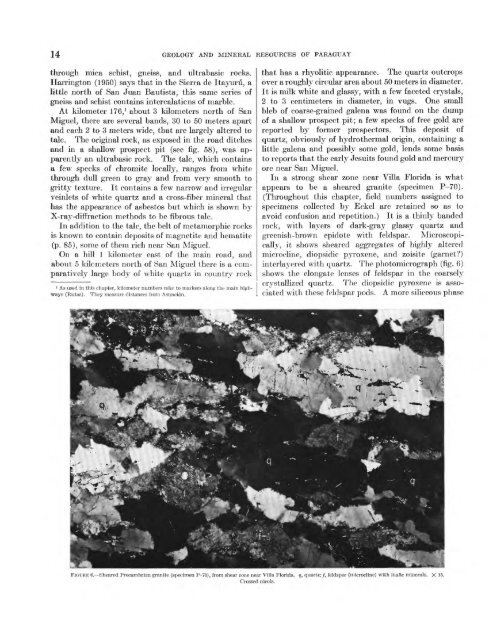Geology and Mineral Resources of Paraguay A Reconnaissance
Geology and Mineral Resources of Paraguay A Reconnaissance
Geology and Mineral Resources of Paraguay A Reconnaissance
- No tags were found...
You also want an ePaper? Increase the reach of your titles
YUMPU automatically turns print PDFs into web optimized ePapers that Google loves.
14 GEOLOGY AND MINERAL RESOURCES OF PARAGUAYthrough mica schist, gneiss, <strong>and</strong> ultrabasic rocks.Harrington (1950) says that in the Sierra de Itayuru, alittle north <strong>of</strong> San Juan Bautista, this same series <strong>of</strong>gneiss <strong>and</strong> schist contains intercalations <strong>of</strong> marble.At kilometer 176,' about 3 kilometers north <strong>of</strong> SanMiguel, there are several b<strong>and</strong>s, 30 to 50 meters apart<strong>and</strong> each 2 to 3 meters wide, that are largely altered totalc. The original rock, as exposed in the road ditches<strong>and</strong> in a shallow prospect pit (see fig. 58), was apparentlyan ultrabasic rock. The talc, which containsa few specks <strong>of</strong> chromite locally, ranges from whitethrough dull green to gray <strong>and</strong> from very smooth togritty texture. It contains a few narrow <strong>and</strong> irregularveinlets <strong>of</strong> white quartz <strong>and</strong> a cross-fiber mineral thathas the appearance <strong>of</strong> asbestos but which is shown byX-ray-diffraction methods to be fibrous talc.In addition to the talc, the belt <strong>of</strong> metamorphic rocksis known to contain deposits <strong>of</strong> magnetite <strong>and</strong> hematite(p. 85), some <strong>of</strong> them rich near San Miguel.On a hill 1 kilometer east <strong>of</strong> the main road, <strong>and</strong>about 5 kilometers north <strong>of</strong> San Miguel there is a comparativelylarge body <strong>of</strong> white quartz in country rock1 As used in this chapter, kilometer numbers refer to markers along the main highways(Rutas). They measure distances from Asuncion.that has a rhyolitic appearance. The quartz outcropsover a roughly circular area about 50 meters in diameter.It is milk white <strong>and</strong> glassy, with a few faceted crystals,2 to 3 centimeters in diameter, in vugs. One smallbleb <strong>of</strong> coarse-grained galena was found on the dump<strong>of</strong> a shallow prospect pit; a few specks <strong>of</strong> free gold arereported by former prospectors. This deposit <strong>of</strong>quartz, obviously <strong>of</strong> hydrothermal origin, containing alittle galena <strong>and</strong> possibly some gold, lends some basisto reports that the early Jesuits found gold <strong>and</strong> mercuryore near San Miguel.In a strong shear zone near Villa Florida is whatappears to be a sheared granite (specimen P-70).(Throughout this chapter, field numbers assigned tospecimens collected by Eckel are retained so as toavoid confusion <strong>and</strong> repetition.) It is a thinly b<strong>and</strong>edrock, with layers <strong>of</strong> dark-gray glassy quartz <strong>and</strong>greenish-brown epidote with feldspar. Microscopically,it shows sheared aggregates <strong>of</strong> highly alteredmicrocline, diopsidic pyroxene, <strong>and</strong> zoisite (garnet?)interlayered with quartz. The photomicrograph (fig. 6)shows the elongate lenses <strong>of</strong> feldspar in the coarselycrystallized quartz. The diopsidic pyroxene is associatedwith these feldspar pods. A more siliceous phaseFIGURE 6. Sheared Precambrian granite (specimen P-70), from shear zone near Villa Florida, g, quartz; /, feldspar (microcline) with mafic minerals. X 15.Crossed nicols.
















